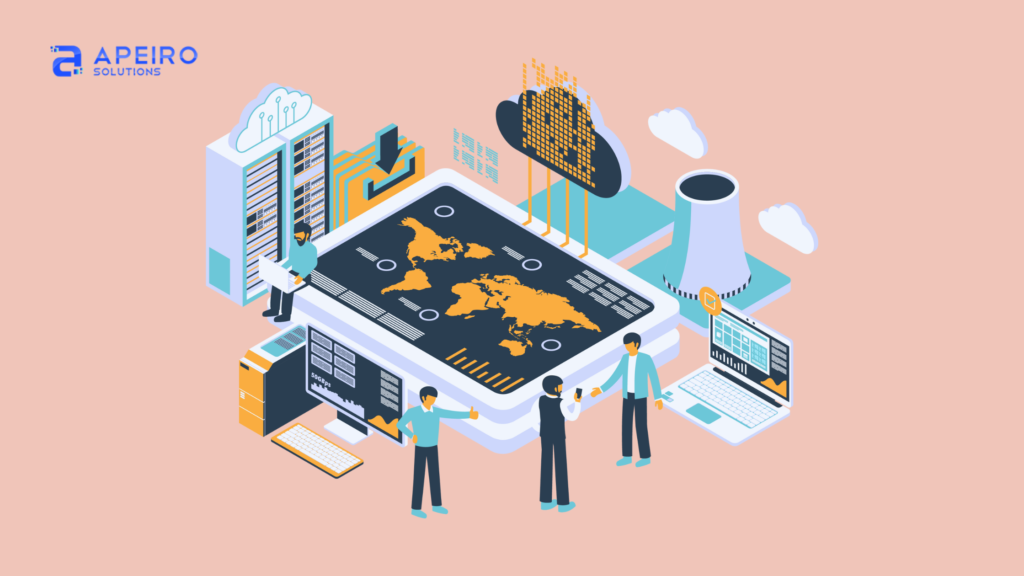
Businesses use data mining companies like Apeiro Solutions to help them glean valuable insights from a huge amount of data. In today’s B2B ecosystem, data has evolved from a supporting tool to a central pillar for decision-making, competitive edge, and sustainable growth. Businesses that prioritize intelligent data interpretation are better equipped to optimize operations, respond to market changes, and build long-lasting customer relationships.
This blog outlines what data mining is, how it works, and why it is increasingly critical for B2B companies to adopt these capabilities for improved performance and innovation.
Understanding Data Mining in the B2B Context
Finding hidden patterns, connections, and trends in massive databases through analysis is known as data mining. It is a technical blend of computer science, statistics, and artificial intelligence. Through systematic data processing, companies can detect behaviors, forecast outcomes, and support decision-making.
The real strength of data mining lies in its ability to turn raw, unorganized data into actionable intelligence. B2B companies, in particular, generate extensive data through interactions, transactions, and operations. When mined correctly, this data reveals opportunities for lead generation, sales optimization, and long-term strategy formulation.
The Key Steps in the Data Mining Lifecycle
To be effective, data mining follows a structured approach involving several essential phases:
1. Data Collection
Information is gathered from multiple sources such as CRM systems, website interactions, email engagement, and third-party databases. The goal is to build a comprehensive, unified dataset.
2. Data Cleaning and Preparation
Collected data is cleaned to remove duplicates, correct inconsistencies, and handle missing values. This guarantees that the analysis is founded on trustworthy sources.
3. Data Transformation
Data is normalized and reformatted to align with the needs of analytical models. This step often includes creating calculated metrics, combining data points, or reducing dimensionality.
4. Mining and Analysis
Advanced algorithms are applied to discover patterns. These could be predictive models, segmentation clusters, or association rules, depending on business goals.
5. Interpretation and Deployment
The insights are interpreted in a business context and integrated into decision-making processes. The outcomes may inform sales strategies, customer engagement, or risk mitigation efforts.
Data Mining vs Traditional Market Research
Traditional market research relies on surveys, focus groups, and interviews methods that are time-consuming and often limited by sample size. On the other hand, data mining scales easily and leverages real-time behavioral data.
| Criteria | Data Mining | Traditional Research |
| Speed | Real-time insights | Slower, manual data collection |
| Scalability | Handles big data | Limited sample size |
| Cost | Uses existing data | Requires dedicated resources |
| Accuracy | Objective patterns | Self-reported biases |
| Depth | Deep behavioral insights | Surface-level opinions |
For B2B brands aiming to respond faster and make smarter moves, data mining offers an undeniably stronger foundation for strategic planning.
Benefits of Data Mining for B2B Businesses
Data mining enables B2B companies to refine how they approach markets, engage clients, and manage resources. Here’s how it drives performance:
1. Customer Segmentation
By clustering customers based on firmographics, behavior, or transaction history, businesses can personalize outreach and customize offerings. Better segmentation leads to higher engagement and improved retention.
2. Sales and Marketing Optimization
Data mining highlights which channels drive conversions, when buyers are most active, and what content resonates. This aid marketing teams in developing more successful campaigns and sales teams in concentrating on the most promising leads.
3. Cross-Selling and Up-Selling
Purchase histories reveal logical product or service extensions. Mining this data helps reps suggest relevant add-ons or upgrades, increasing revenue per customer.
4. Operational Efficiency
Data from internal processes or the supply chain can be analyzed to identify and fix inefficiencies. Companies can better manage inventory, reduce turnaround time, and cut overhead costs.
Predictive Analytics: Forecasting the Future
Predictive modeling is one of the most powerful outcomes of data mining. B2B organizations can estimate future sales, identify churn risks, or predict customer needs. These forecasts enable proactive actions like adjusting pricing, allocating resources, or launching retention campaigns.
From anticipating market shifts to determining optimal customer touchpoints, predictive analytics helps companies stay a step ahead in competitive markets.
AI, Machine Learning, and Data Mining: The Synergy
While data mining extracts meaningful insights, AI and machine learning bring intelligence and adaptability to the table. These technologies enhance traditional data mining processes through automated pattern recognition and real-time analysis.
For instance, machine learning algorithms can refine their performance over time, identifying customer lifetime value or predicting sales cycles with increasing accuracy. AI-driven tools can even process unstructured data such as support tickets or online reviews, providing a more holistic view of customer sentiment.
Together, these technologies empower B2B companies to make smarter, faster, and more scalable decisions.
Conclusion
The gap between information and action is where data mining companies like Apeiro Solutions make a transformative impact. By turning unstructured data into strategy-ready insights, businesses are better equipped to understand customer needs, anticipate market changes, and optimize performance across departments.
